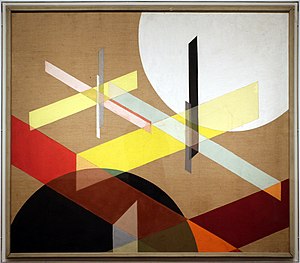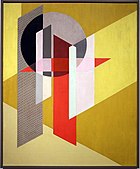Composition Z VIII

|
| Composition Z VIII |
|---|
| László Moholy-Nagy , 1924 |
| Glue paint and graphite on unprimed canvas |
| 114 × 132 cm |
| Neue Nationalgalerie , Berlin, (inventory number: NG 5/59) |
Composition Z VIII is the title of a painting by László Moholy-Nagy from 1924. It was created at the time when the artist was a teacher at the Dessau Bauhaus . The abstract picture can be assigned to constructivism and has belonged to the collection of the Berlin New National Gallery since 1959 .
Background and description
Z VIII belongs to the series of pictorial compositions that Moholy-Nagy created between 1922 and 1926. In retrospect, the artist saw his work at that time as “efforts aimed at overcoming the dye (the pigment) or at least sublimating it as far as possible in order to get out of the elementary material of optical design, out of direct light, expression to realize. that was intuitively the goal of constructivism, even if its practice was at most up to a technical preliminary stage where injection molding technology reached. ”(Bauhaus-typical lower case as in the original).
Moholy-Nagy later experimented with the spray technique, but the composition Z VIII shows an even application of paint with a brush. The geometric shapes of the circle, trapezoid, vertically stretched parallelogram and triangle overlap, penetrate and cross each other at right angles. In this way they create different translucent colors and brightness values. Two of the transparent circular disks typical of Moholy-Nagy's Bauhaus period are trimmed and overlapping in white at the top right of the picture and in black at the bottom left. With these overlays, Moholy-Nagy creates spatial depth from the two-dimensional surface without using the construction of a perspective, as is traditionally used in realistic painting. In addition, the canvas is not primed and, in the opinion of Dieter Honisch , the former director of the New National Gallery in Berlin, this gives it the character of an object. The art historian Joyce Tsai describes Moholy-Nagy's painting technique in this picture as tempera painting on unprimed canvas, the chalky structure of which is supposed to hide the texture of the brushstroke and thus the “hand of the artist”. Moholy-Nagy tries to create the “illusion of luminous, crystalline forms” with the choice of colors in connection with the strict geometric shapes. The art historian Walter Kambartel sees himself in the composition, which repeats the two-dimensional elements, in Claude Monet's series on the cathedral of Rouen remind. He recognizes a light painting, which, however, takes an opposite position because Moholy-Nagy creates an interaction through transparency, similar to that in Gothic church windows, and not through spectral colors as in Monet's.
- Two more works in the Z series
Z VI
(1925, Harvard Art Museums )Z VII
(1926, National Gallery of Art )
Provenance and exhibition (selection)
The painting Composition Z VIII belonged to the collection of the art dealer Hans-Hellmut Klihm (1917–1980). In 1959 the Neue Nationalgalerie, Berlin acquired it from the art cabinet Klihm in Munich. It has since been recorded there under the inventory number NG 5/59.
- September 24 to November 19, 1961: The storm . Herwarth Walden and the European Avant-garde, Berlin 1912–1932. West Berlin's New National Gallery in the Great Orangery of Charlottenburg Palace
- October to November 1967: Avant-garde Eastern Europe 1910–1930. New Berlin Art Association and Academy of the Arts
- August 2 to October 16, 1977: Trends in the twenties. 15th European Art Exhibition Berlin 1977. New National Gallery, Academy of Arts and Great Orangery, Charlottenburg Palace
- November 11, 1983 to January 6, 1984: Cosmic Images in 20th Century Art. State art gallery Baden-Baden
- February 11 to April 7, 1991: László Moholy-Nagy. Institut Valencià d'Art Modern Center Julio González , Valencia, Spain
- May 27 to September 7, 2016: Moholy-Nagy: Future Present at the Solomon R. Guggenheim Museum , New York
- October 2, 2016 to January 3, 2017: Moholy-Nagy: Future Present at the Art Institute of Chicago .
literature
- Karl Ruhrberg, Klaus Honnef, Manfred Schneckenburger, Christiane Fricke: László Moholy-Nagy Composition Z VIII . In: Ingo F. Walther (Ed.): Art of the 20th Century . Part I. Taschen, Cologne 2000, ISBN 3-8228-5907-9 , pp. 178 (English, books.google.de ).
Web links
- Website image index with a description of the image
Individual evidence
- ↑ Neue Nationalgalerie Berlin: Look at this art! From Ferdinand Hodler to Fernand Léger - the museum has viewed its holdings and put them on display. In: Die Zeit Online. March 12, 2010, accessed on February 25, 2019 (Fig. 6).
- ↑ László Moholy-Nagy: instead of color: light . In: From material to architecture (= Bauhaus Books . No. 14 ). Albert Langen Verlag, Munich 1929, p. 88 f . ( uni-heidelberg.de ).
- ↑ Dieter Honisch in: Staatliche Museen Preußischer Kulturbesitz (Ed.): Art of the World in the Berlin Museums, State Museums of Prussian Cultural Heritage. Stuttgart / Zurich 1980, p. 86.
- ↑ Internet page picture index
- ↑ Joyce Tsai: László Moholy-Nagy: Painting after Photography. University of California Press, Oakland 2018, ISBN 978-0-520-29067-9 , p. 117
- ^ Walter Kambartel in: Propylaea Art History Volume 12 . Berlin 1984, ISBN 3-549-05640-0 , p. 216 f.
-
^ Moholy-Nagy: Future Present. Art Institute of Chicago - Artsy, accessed February 17, 2019 . Susan Snodgrass: Moholy-Nagy: Future Present. In: ARTMargins. Retrieved February 17, 2019 .

